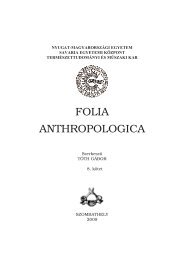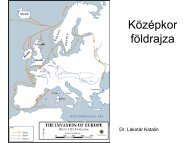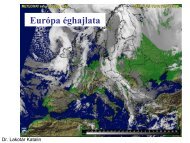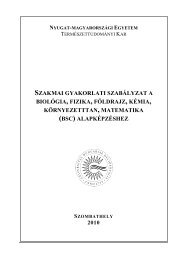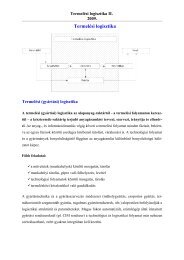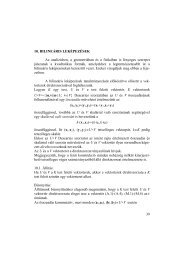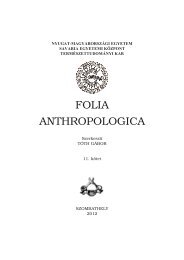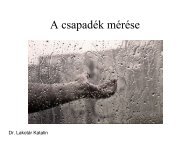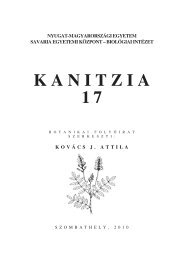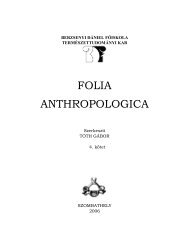Kanitzia 18. - NYME Természettudományi Kar - Nyugat ...
Kanitzia 18. - NYME Természettudományi Kar - Nyugat ...
Kanitzia 18. - NYME Természettudományi Kar - Nyugat ...
You also want an ePaper? Increase the reach of your titles
YUMPU automatically turns print PDFs into web optimized ePapers that Google loves.
posals, the population-stands from the Transylvanian Basin (Romania) belong to the K.<br />
ceratoides (L.) Gueldenst., and they probably had been in a kind of historical and biogeographical<br />
relationships with the other disjunct population-stands of the species distributed<br />
in Europe (E. Russia, C. Ukraine, Makedonia, Spain) or North Africa (Marocco, Algeria)<br />
(Ball 1996, Jalas & Souminen 1980, Dominguez et al. 2001), and mostly with the populations<br />
in Lower Austria (Goggendorf, Oberschoderlee (Janchen 1956, Adler et al. 1994) and<br />
in the Transdanubian Hungary (Nagyhörcsök-puszta) described by Schilberszky (1891),<br />
which already disappeared [Farkas (ed.) 1999, Király (ed.) 2009]. For the Transylvanian<br />
Basin (Romania) the species was discovered by Soó (1945) near Vultureni/Borsaújfalu<br />
(Someş Tableland/ Szamosháti-dombság), followed later by other three recorded localities<br />
from the area of the Transylvanian Lowland in the last decade: Groapa Rădăii (Laposdülő)<br />
(Bădărău et al. 2002), Poiana Frăţii (Bethlentanya) (BĂDĂRĂU et al. ined., KOVÁCS 2009<br />
ined.), Pănet (Mezőpanit) (KOVÁCS 2009 ined.). Our records have been realized during the<br />
field works and investigations on the dry- and semi-dry grasslands, meadow-steppes, xerothermic<br />
plant communities in the Transylvanian Basin (KOVÁCS 2009), when we investigated<br />
the forest-steppe area in the south-eastern part of the Transylvanian Lawland also. It<br />
is curious that on the basis of the Transylvanian forest steppe characteristics the species<br />
appearances/occurences could have predicted for a long time, particular floristic studies,<br />
vegetation surveys and nature protection works for the Transylvanian Lowland (PRODAN<br />
1931, SOÓ 1949, CSŰRÖS et al. 1961, RESMERIŢĂ et al. 1968, NIEDERMAIER 1970, POP I. et<br />
al. 2002, DONIŢA & et al. 2005, SÂRBU et al. 2007) did not indicate any data about the<br />
species presence in this region. Do to the investigation of BĂDĂRĂU et al. (2002) completed<br />
with present contribution, the number of species occurences in the Transylvanian Basin<br />
rises to four localities. The necessity of evaluation of these population-stands constitue a<br />
main task for vegetation ecology and phytocoenology. The present survey contributes new<br />
data to elucidate the ecological characteristics and to establish the coenological relations<br />
of the Krascheninnikovia ceratoides-stands in the Transylvanian Basin.<br />
The wide holartic distribution and the large ecological areas (semi-deserts,<br />
steppes, dry grasslands) of K. ceratoides is in relation with the main biological characteristics<br />
of the plant: that half-shrub growing form, „protective” stellate hairs, short perennial<br />
main axis with the possibility to develep numerous branches, woody anatomy with succesive<br />
cambial activity, tetraploidy (2n=36), outbreeding population structure, and several<br />
other characteristics which contributed to the ancient and present chorological succes, especially<br />
in colonizing altered areas (MORARIU 1952, MOHAJERY & RASTI 1995, BALL 1996,<br />
DOMINGUEZ et al. 2001, HEKLAU & RÖSER 2008).<br />
Matherials and methods<br />
During our field investigation on the distribution and structure of the dry and semidry<br />
grassland vegetation in the Central and Eastern part of the Transylvanian Basin (2009)<br />
we identified two new sites/provenance for the species Krascheninnikovia ceratoides near<br />
the following localities: Pănet (Mezőpanit) in the place named „Dl. Şico” (Sikó-hegy)<br />
Mureş county, and near the Poiana Frăţii (Bethlentanya), Frata in the place named „Onisie”<br />
Cluj county. Consulting the recent Romanian botanical works and monographies (OPREA<br />
61




